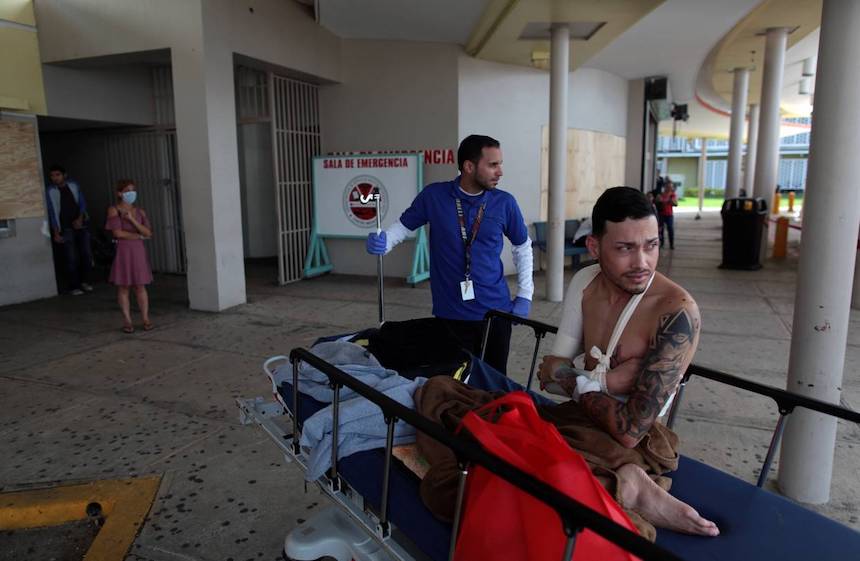
Hurricane Maria has put pressure on Puerto Rico’s health-care system, but a looming budgetary shortfall could be even more devastating. Ted Alcorn reports.
A fortnight after Hurricane Maria made landfall on Puerto Rico, the island’s shattered health system struggled to meet even basic needs, and girded itself for a lengthy recovery
Because municipal electricity had been returned to only a fraction of the island, hospitals were operating with power from backup generators but struggling to maintain supplies of diesel fuel. Phone service was patchy, particularly in the mountainous region in the island’s centre, which hindered assessments of the needs of remote facilities. “We are using social media and Facebook to try to communicate with the hospital administrators around the island“, said Gilberto Gonzalez, chief executive officer of the College of Healthcare Administrators of Puerto Rico. He added that relief workers who have been working around the clock need to be relieved.
Interruptions in health care were a particular concern for vulnerable populations, among them people with diabetes. One in seven Puerto Rican adults has been diagnosed with the disease, a higher prevalence than in any US state, and the survival of some 6000 Puerto Ricans with kidney failure depends on regular dialysis treatment.
In the days following the storm, many of the country’s dialysis centres were closed due to lack of power or water, but by October the situation had brightened. Chris Brown oversees the territory’s centres as executive director of the non-profit Quality Insights Renal Network 3, and said that all but 33 of the island’s dialysis patients had been in touch with their main dialysis provider at least once since the storm hit. About half of the island’s dialysis centres had access to water either through municipal systems or wells and all but four were up and running on generators. “The long-term sustainability of this really comes down to: can those supplies be maintained on a regular basis, both diesel and water?” Brown said.
Even as Puerto Ricans attend to the health system in the wake of this natural disaster, a man-made disaster is looming. 1·4 million Puerto Ricans are enrolled in the territory’s Medicaid programme, known as Mi Salud, and by spring of 2018, the federal funding that supports two thirds of its budget will run out, with no plan yet to replace it.
The funding, allotted as a one-time measure under the Affordable Care Act, was intended as a patch for an imbalance that is decades old. Since the inception of the Medicaid program in 1965, the federal government has paid a share of each state’s expenses, as much as 82% for the poorest ones. But the federal contribution to territories like Puerto Rico is capped, regardless of their low per capita income and high poverty rate. Between 1999 and 2011, Puerto Rico was effectively reimbursed for just 17% of its Medicaid costs.
With such little federal support, the territory has struggled to meet the health needs of its residents, and coping with austerity has created additional problems. To shave off costs, Mi Salud does not offer some benefits that are mandatory in the rest of the USA, foregoing nursing facility and home health services for elderly people and limiting coverage of early and periodic screening, diagnostic, and treatment services for children. Clinicians receive very low rates of reimbursement for their services, which has propelled an exodus of thousands of health-care workers to the mainland in recent years, draining Puerto Rico’s health system of much needed expertise.
In May, the US Congress appropriated US$296 million to get Puerto Rico’s Medicaid programme through the fiscal year. A spokesman for Congresswoman Nydia Velásquez said she is advocating that a more durable solution be included in the funding bill in response to the hurricane. If the stopgap funding runs out before lawmakers resolve on a way to replace it, the territory will fall off a fiscal cliff: the Medicaid and Children’s Health Insurance Program Payment and Access Commission predicts a budgetary shortfall of $877 million in 2018 alone.
This would leave Puerto Rican lawmakers with tough choices to make. Ricardo Rivera-Cardona, who oversaw Mi Salud from 2013–16 as executive director of the Puerto Rico Health Insurance Administration, says: “Either you reduce benefits or you take one million people out of the programme—which creates a huge impact on the lives of close to a third of the population”.
The territory’s immediate needs are so urgent that it is hard to look beyond them, but some people hope the crisis will open up space for fresh approaches to the structural challenges the island is facing. Maria Levis, the chief executive officer of the social impact consulting firm Impactivo, rode out the hurricane in San Juan and has been talking with clients around the island in the weeks since. “We have just been hit with a storm that has devastated all of our basic systems. Our folks are suffering and there’s a lot of poverty currently. And it’s a good time to think very deeply about the type of health system we want to reconstruct.”
Ted Alcorn, The Lancet

